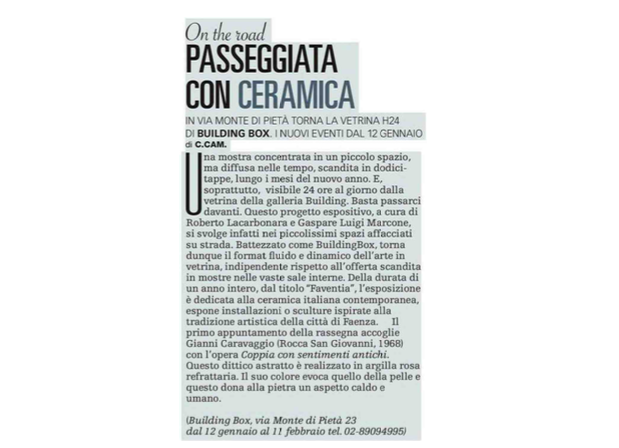FAVENTIA – 1/12. Gianni Caravaggio
12.01.2024 – 11.02.2024
From January 12th to February 11th 2024, BUILDINGBOX hosts the artwork Coppia con sentimenti antichi (2016) by the artist Gianni Caravaggio (Rocca San Giovanni, 1968).
The first artwork exhibited in FAVENTIA. Ceramica italiana contemporanea [Contemporary Italian Ceramics], was made with refractory pink clay that gives the sculpture fleshy and “humanising” qualities. This choice belongs to the quest for an archetype, an expressive primacy defined by technique and material, as well as the symbolic and iconological references of sculpture. The cylindrical shape of the clay, sectioned into two parts using an iron wire while the clay was still wet, shows the signs of the cut inflicted on the compact volume, which here appears as opened to reveal a new configuration. On closer inspection, this cleft shows that the two sections do not perfectly coincide, demonstrating the non-correspondence and absolute individuality of the subjects that make up the couple.
It is precisely the theme of the couple that Caravaggio explores, evoking Plato’s famous Symposium (4th century BC) in which he recounts Zeus’ peremptory gesture of splitting the original unity of the individual in two, shattering their wholeness, producing the distinction between male and female, and forcing mankind to the perennial search for a lost perfection. Hence the choice to arrange the two bodies of the sculpture in opposite directions, giving them a position that alludes to the “melancholic shape” of infinity, and marks the opening towards an unknown destiny. By showing their feelings and inner being, the two souls face history and reach eternity, in an agreement that unites but does not bind.
Through this solution, Caravaggio examines a very archaic recurrent theme found in the Etruscan terracotta figures placed on spouses’ sarcophagi, immortalising the relationship between the two spouses, as well as indirectly evoking the Old Testament act of the creation/separation of Adam and Eve. Moreover, if the mythical language recounts of Chronos, god of time, cutting the wings of Eros, bringing idealised and ethereal love back to earth, simultaneously denoting the time’s will to dominate love, even this act that separates and distances the sculptures produces a new dimension, bringing dualism back into the heart of unity and delivering totality to eternal becoming. For Caravaggio, the choice of matter is always emblematic, and it becomes an artistic and conceptual “material”: in fact, Coppia con sentimenti antichi is made of clay, the primary and primordial material of the sculptural act. The work was created in the workshops of the Museo Carlo Zauli in Faenza.
From January 12th, 2024, to January 11th, 2025, BUILDINGBOX presents FAVENTIA. Ceramica italiana contemporanea [Contemporary Italian Ceramics], an exhibition project curated by Roberto Lacarbonara and Gaspare Luigi Marcone, involving twelve Italian artists invited to exhibit sculptures and installations made of ceramics. This programme is dedicated to the centuries-old artistic tradition of the city of Faenza, one of Italy’s main production districts, as well as the seat and epicentre of themed projects and museums such as the “MIC International Ceramics Museum”, the “Premio Faenza”, and the “Museo Carlo Zauli”. Furthermore, the exhibition was conceived as a tribute toward an area affected by the flood of May 2023.
As with BUILDINGBOX’s usual annual schedule, the exhibition hosts monthly interventions. In this edition, the artworks will be presented on the 12th day of each month. This “numerology” alludes to the cyclical nature and synthesis of earthly, spiritual, and temporal elements, as well as the numerous symbologies associated with the number 12 in history and cultures from different parts of the world.
The project maps and summarises some of the main artistic expressions related to the 20th and 21st centuries ceramics, promoting a series of artists from different generations who, consistently or sporadically with respect to their own production, use clay working techniques by continuing, recovering, or revolutionising the extraordinary manual skill of moulding, and the chromatic-luminist value of the glazes.
The ancient Faventia has been a land of artisan production since Roman times, a characteristic that was enhanced in later centuries. Indeed, it became synonymous of the majolica ceramics in many languages – French (faïance), English (faience). In recent years, many artists have used the Faenza kilns – also thanks to residency programmes, exhibitions, workshops, prizes, and publications – for the artistic production of medium and large-scale sculptures, often designed for an environmental development and installation purposes. The primal, demiurgic act of shaping the clay gives ceramics an exclusive status, almost an ontology, the auroral condition of sculpture. In the manipulation’s plastic immediacy that precedes the firing that crystallises the piece, there is all the naturalness of a slow, thoughtful transformation poised between design and chance. In ceramics, as in drawing, there is the seed of an origin, that appears on the surface of the image and things in the precise moment of their conception. Ceramics – beyond the categorisations between craft, art, functional objects, unique, or mass-produced piece – possesses an intermediary (or intermediality) between thought and gesture, sign and sculpture, form and colour, operating, moreover, with various natural elements such as earth, water, and fire; and by hybridising artistic languages, techniques, research, and knowledge between artists and artisans.













